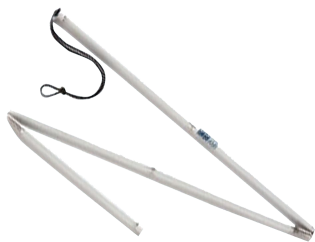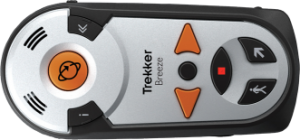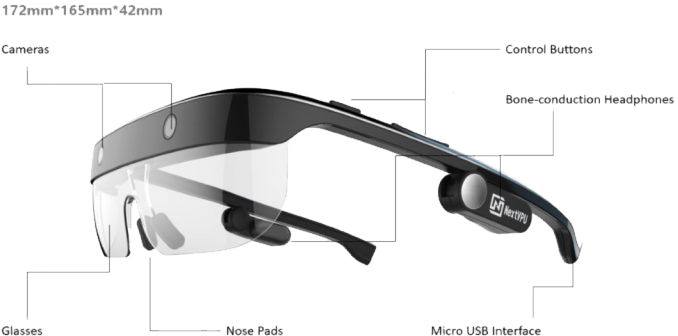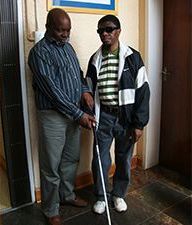Mobility Aids
Contents: To jump to the topic you would like, click on the links below
Introduction
There are a wide range of Assistive Devices that have been developed and are available for persons who are Blind or Visually Impaired, so that they can be more mobile and independent. These assistive devices are known as Mobility Aids and can range in price and include both "low tech" inexpensive devices such as White Canes, as well as more expensive "high tech" equipment, such as Smart Glasses. The Mobility Aids listed on this page don't only include equipment, but can also include Guide Animals and Accessible Features, such as Tactile Paving. Orientation Techniques can also be taught and used by persons who are Blind or Visually Impaired, so that they can be more mobile. These Orientation Techniques & the use of White Canes or Guide Dogs + Accessible Features which the Government has introduced, can help persons who are Blind, to be able to travel around & navigate successfully from point A to point B. Some persons who are Blind use a wide range of these Mobility Aids, while others only require one or two of them to be able to travel independently.
There are various Organizations and Companies such as Blind SA, Sensory Solutions and Edit Microsystems, which sell or offer a wide variety of these Services and Mobility Aids. Many of these Organizations & Companies can also advise you on what equipment would best suit your needs and how to use the equipment that they supply.
Edit Microsystems: Edit Microsystems (Pty) Ltd is an award-winning company that is devoted to finding alternative and state-of-the-art technical solutions to improve curriculum delivery in educational institutions and effective communication in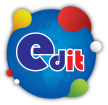 business with a focus on high-speed functional connectivity and on-going support. They have a proud tradition of innovation and are on the cutting edge of technological advances in education. Many of their products are designed to enhance interactivity in a classroom or lecture theatre. Edit Microsystems are also a leader in finding and providing specially adapted hardware and software for Learners with Special Educational Needs throughout South Africa.
business with a focus on high-speed functional connectivity and on-going support. They have a proud tradition of innovation and are on the cutting edge of technological advances in education. Many of their products are designed to enhance interactivity in a classroom or lecture theatre. Edit Microsystems are also a leader in finding and providing specially adapted hardware and software for Learners with Special Educational Needs throughout South Africa.
Edit Microsystems can be contacted on: 086 111 3973 and have their Head Office in Cape Town at: 13 Boy De Goede Circle, Table View, 7441. They also have an online shop and branches in KwaZulu-Natal, Mpumalanga, Gauteng.
To contact these other branches or find out more about Edit Microsystems and the products they supply, visit their web site at: www.editmicro.co.za or email them at: info@editmicro.co.za.
Blind SA: Blind SA is a national Disable People’s Organisation (DPO) of the blind and for the blind. Established in 1946 as the South African Blind Workers Organisation (SABWO) and became Blind SA in 2004. Head office is situated at 5 Fuchs Street, Alrode, Alberton, however our services are rendered to blind and visually impaired in all provinces in South Africa
The vision of Blind SA is to do whatever is necessary or conducive to empower visually impaired people to become economically self-supporting and to live a full and meaningful life as citizens of South Africa.
The biggest challenges faced in our communities are the shortage of financial resources to enable our blind and visually impaired beneficiaries to reach their full potential as independent members of society.
The impact that Blind SA has had on the community is a more informed, empowered and enabled blind and visually impaired community. Because we have so many such people who are in serious need of our assistance, we would welcome the opportunity and resources to be able to reach more people with the view of creating a self-supporting, independent and informed blind and visually impaired community throughout South Africa.
“Our Purpose is to end the cycle of poverty for Blind South Africans, empowering them with knowledge and information through education, braille and developmental services and to break down barriers, provide opportunities and create answers that improve the quality of life for the blind community so that they can live the life they choose.”
Blind SA are also Orientation and Mobility Practitioners and also stock and sell a variety of Assistive Devices to assist persons who are Blind, these include the Mali-Bhala, Tatrapoint Mechanical Brailler and Braille-Me. For any other requirements, contact Blind SA on: Tel: +27 11 839 1793/4 or Email: ceo@blindsa.org.za, Jennine Pare - sales@blindsa.org.za, or visit us at: Address: 5 Fuchs Street, Alrode, Gauteng, South Africa. Website: www.blindsa.org.za.
Sensory Solutions: Sensory Solutions is a South African company with considerable experience in the field of accommodating persons who are visually impaired, blind or partially sighted. We specialise in the field of providing Access Technology solutions for individuals, schools, universities, government departments and more, in order to make the environment more accessible for the visually impaired.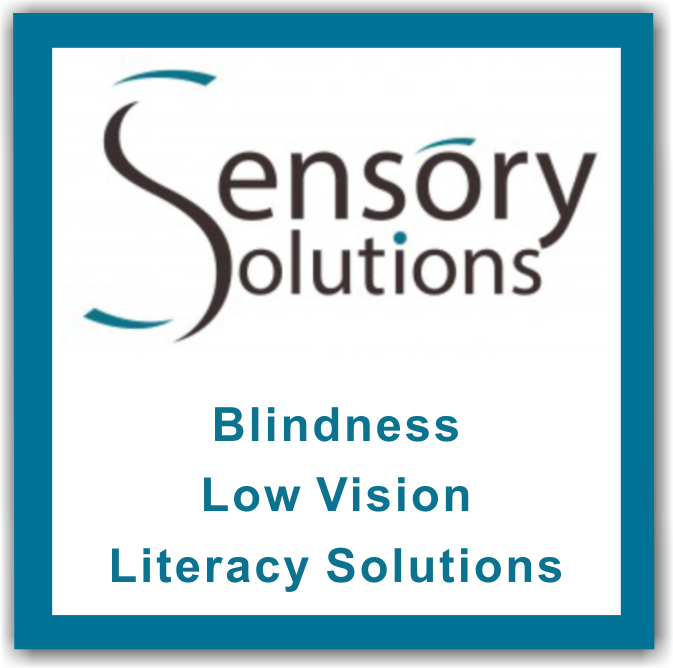
Sensory Solutions is at the forefront of the world’s leading Access Technology products and are in some cases the exclusive distributors. Sensory Solutions is a responsible employer which employs people from previously disadvantaged backgrounds as well as those who are disabled. Part of our mission is to advise individuals and institutions on the best solutions available for particular environments, to design such solutions and finally to implement them on site. As such, we are approved African distributors for a wide range of Access Technology products selected specifically for their suitability to the African environment and our specific situation.
We are proud to be appointed exclusive and preferred dealerships for some of the world’s most leading Access Technology manufacturers. Our mission and ethos revolve around our fellow man, empowering them and making the playing fields level as far as we can make a difference.
Whether you are an individual, institution or company in need of information regarding Access Technology, we are ready to assist you. Please feel free to contact us at our Head Office on: +27 12 664 7704 or at 226 Kruger Avenue, Lyttelton Manor, Centurion, 0157. Email: info@sensorysolutions.co.za, khan@sensorysolutions.co.za or visit our website at: www.sensorysolutions.co.za
Below are some of these Mobility Aids & Techniques that can assist persons who are Blind or Visually Impaired to move around. To view more information about these, read the article below.
Guide Dogs & Equipment
A Guide Dog is a Service Animal used by persons who are Blind or Visually Impaired. Service animals are defined as animals that are individually trained to do work or perform tasks for persons with disabilities, they are working animals and not pets, so the
work or task that the animal has been trained to provide must be directly related to the person's disability. Animals whose sole function is to provide comfort or emotional support do not qualify as service animals. There are various types of Service Animals used in countries around the world, including Guide Horses in the UK and Service Monkeys in USA, but these are currently not trained or used in South Africa. Guide Dogs and training is available from various organizations in South Africa for persons who are Blind or Visually Impaired, while training of various other types of Service Dogs is also available to assist Persons With Disabilities, such as:
- Mobility Impairments: Service Dogs - Pulling a wheelchair or picking up objects.
- Diabetes: Medical Alert Dogs - reminding / detecting when a person needs to take prescribed medications.
- Hearing Impairments: Hearing Dogs - Alerting people who are Deaf.
- Mental Illnesses (Posttraumatic Stress Disorder (PTSD): calming a person with (PTSD) during an anxiety attack
- Seizure Disorder: Seizure Alert Dogs - Alerting and protecting a person who is having a seizure.
- Autism: Autism Support Dogs - Preventing children with autism from running off when distracted.
In several countries, including South Africa, Service Dogs, Guide Dogs, Hearing Dogs, etc. are exempt from regulations against the presence of animals in places such as restaurants, public transportation and aeroplanes. To find out more about the types of Service Dogs mentioned above, click on the links, or click the link below to find out more about Guide Dogs and the Organizations that train and provide them.
White Canes/Mobility Canes
A White Cane, sometimes known as Mobility Canes, is a thin white stick used as a Mobility Aid by Persons who are Blind or Visually Impaired, they are used to improve their mobility and to scan their surroundings for obstacles or orientation marks. Mobility Canes are often made from aluminium, graphite-reinforced plastic or other fibre-reinforced plastic, and can come with a wide variety of tips depending upon user preference.
Techniques for cane travel can vary depending on the user and/or the situation. A White Cane also help for other traffic and in identifying the user as Blind or Visually Impaired. The White Cane with a red tip is the international symbol of blindness and the Cane's prominent white colour helps to identify it, and is mandatory in many jurisdictions. There are however a variety of different types of Canes that can be used by Persons With Visual Impairments, the choice depends on the individual's vision, motivation, and a variety of other factors. The different options of Canes include:
A Long Cane: This Cane is used to extend the user's range of touch sensation. It is usually swung in a low sweeping motion, across the intended path of travel, to detect obstacles. This is the traditional white cane and can also be known as a "Hoover Cane". The Cane length depends upon the height of a user, and traditionally extends from the floor to the user's sternum. Some Organizations favor the use of much longer canes.
Guide Cane: This is a shorter Cane and generally extends from the floor to the user's waist. It has a more limited mobility function and is used to scan for kerbs and steps. The guide cane can also be used diagonally across the body for protection, warning the user of obstacles immediately ahead.
Identification (ID) Cane: The ID cane is used primarily to alert others as to the bearer's Visual Impairment. It is often lighter and shorter than the long cane, and has no use as a mobility tool.
A Support Cane: The White Support Cane is designed primarily to offer physical stability to a person who is Visually Impaired, but the colour of the cane also works as a means of identification. This tool has very limited potential as a mobility device.
Kiddie Cane: This version works the same as an adult's Long Cane but is designed for use by children.
Green Cane: Used in some countries to designate that the user has low vision while the white cane designates that a user is blind.
Types of White Canes
White Canes can be either collapsible or straight, with both versions having pros and cons. It is believed that the lightness and greater length of the straight canes allows greater mobility and safety, but collapsible canes can be stored with more ease, giving them an advantage in crowded areas such as in classrooms and at public events. There are a variety of different types and sizes of these White Canes that are sold in South Africa including the following which are sold by organizations such as the South African National Council for the Blind, Sensory Solutions and Edit Microsystems:
The Rigid Cane: The Rigid Cane (pictured above right) is made of durable aluminium and does not fold away but stays rigid, it is sold by companies and organisations such as Edit Microsystems and the South African National Council for the Blind. Contact them to receive a quote or to find out more about these Canes.
White Collapsible Canes are also available in South Africa & can either fold away or are telescopic, which helps with storage.
White Folding Canes: This Cane (pictured right), is white and is made of durable aluminium and folds away easily into a bag. It is available to purchase from various organizations & companies such as Edit Microsystems & South African National Council for the Blind, contact them to find out more or to receive a quote.
There are also various other types of these products which are available from companies such as Edit Microsystems, contact them to see what other types of these products they can supply.
Telescopic Canes: are also available in South Africa and are sold by various companies such as Edit Microsystems, they include products such as:
The ila MiniCane Carbon Fiber Telescopic White Cane: (pictured right), this telescopic cane is made of durable carbon fiber. When collapsed, it measures only 9.25″. It comes in a zippered protective case that will fit easily in a purse, back-pack or suitcase. When it is stretched out for use, it measures the full length of the cane, including the handle and tip. The permanent standard tip is made of nylon. A very small, lightweight cane such as this ila MiniCane makes an excellent back-up cane to replace your regular one when it gets lost or broken. It is also good for individuals who use a cane intermittently, as needed. Various sizes are available but subject to stock availability, they include :-45″, 46″, 48″, 49″, 51″, 52″, 55″, 56″, 59″.
This Cane is available to purchase from companies such as Edit Microsytems, contact them to find out more or to receive a quote.
There are also various other types of these products which are available from companies such as Edit Microsystems, contact them to see what other types of these products they can supply.
GPS Devices
Some blind people are skilled at echolocating silent objects simply by producing mouth clicks and listening to the returning echoes. It has been shown that blind echolocation experts use what is normally the "visual" part of their brain to process the echoes.
GPS devices can also be used as a Mobility Aids. These Devices can assist persons who are Blind to navigate themselves, they are not however a replacement for traditional mobility tools such as White Canes and Guide Dogs. GPS devices are available from companies such as Edit Microsystems and are sold in South Africa. They include products such as:
Sunu Band: The Sunu band (pictured right) is a Mobility Aid for persons with Visually Impairements. It combines a sonar or echolocation sensor with a high-resolution vibrating actuator to gently inform the user about objects or obstacles up to 5 meters away. Sunu band augments awareness of the user’s personal space and reduces accidents, ultimately providing a more confident and enjoyable mobility experience. Sunu band Apps allow you to access certain features or perform specific functions. Application on the Sunu band are managed from the Sunu mobile app for iOS and Android (coming soon). Sunu band come with three apps, which include the "Haptic Watch" which access from within the home; the "Vibratory Alarms", which is managed from within the mobile app and the "Obstacle Detection". You can contact Edit Microsytems to find out more or receive a quote.
Trekker Breeze handheld talking GPS: This device (pictured right) is a handheld talking GPS device for users with Low Vision or who are Blind. The device allows the user the navigation of street names, intersections and landmarks as they walk. The handheld GPS ensures that the user is always aware of where they are heading. It announces their location and surrounding areas. The device is user friendly, small, discreet, portable and light to carry around. Features include direct button functions with an intuitive interface and large buttons for easy navigation. It allows for single hand operation with large buttons and has embedded GPS and embedded text to speech. The external speakers have volume adjustable controls with a rotatory wheel. This device includes a carrying case and shoulder strap for easy and secure transportation. It weighs 7 ounces and is only 5 x 2 x 1 inches in size. The battery life lasts up to 8 hours. You can contact Edit Microsytems to find out more or receive a quote.
There are also various other types of these products which are available from companies such as Edit Microsystems, contact them to see what other types of these products they can supply.
AngelEye Smart Glasses
The AngelEye Smart Glasses: are a slim, portable, reliable and powerful intelligent device which has a stylish industrial design and assists Persons who are Blind or have Visual Impairments. These Smart Glasses are based on the most advanced computer vision and artificial intelligence technology and are designed to enable Persons who are Blind or have Visual Impairments, to perceive their daily life. Working with a smartphone or specialized control box, it captures visual information, analyzes and communicates the result in audio back to the Persons with Visual Impairments, so that they can perceive the world.
It’s Features and functions include:
1. A Virtual Cane: The glasses will detect any obstacle that they may hit into, then communicate it to the user through audio. This includes:
- obstacles 125 px higher than the road surface and lower than your height.
- Pits that are 125 px deep from the road.
2. Advanced Recognition: These glasses will recognize 20 object categories and communicate them to the user through voice. Everything is done locally and no wireless connection is needed. The objects that it detects includes: crosswalk, stairs, doors, the exit, cash note, color, text, people, etc.
3. Location Reporting: With a simple push-button, it reports the user’s location information, e.g. street name, next cross’ name, distance to the next cross, heading direction, nearby ROIs etc.
4. Bone Conduction Headphone: The glasses can perform as a fashion bone conduction headphone for music, phone calls, etc.
The AngelEye can only work when connected with smartphone or specialized control box through a USB cable and is used to simulate the functionality of the human eyes, so Persons with Visual Impairments will still need to make their own judgment of the surroundings and take the appropriate action, based on all the information perceived. One Company that sells this product in South Africa is Edit Microsystems. Click on the link to find out more information, or to purchase this product.
There are various other types of Glasses that can be used as Mobility Aids by Persons with Visual Impairments. Click Here to find more various other types of these products which are available from companies such as Edit Microsystems, contact them to see what other types of these products they can supply.
Accessible Features
Accessible Features are features which have been introduced by mostly the Government, to make public places and activities Accessible. There are a wide variety of initiatives and laws which have been introduced through out the world and in South Africa to assist persons with Visually Impairments to live and travel independently and to be able to complete daily tasks and activities, such as Traveling, Shopping, Eating Out and Moving From Point A To Point B. These initiatives help to ensure that equal opportunities and rights are available to persons with Visual Impairments, they include:
- Money - Distinct Shapes & Raised Patterns On Our Coins & Notes
- Service Dogs and Guide Dogs - Rules & Regulations (allowing them in restaurants, public transportation, aeroplanes, etc.)
- The Web Content Accessibility Guidelines
- Braille Atlas
- Audible Traffic Lights.
- Tactile Paving
- Building Regulations that assist the Blind
To view more information about Accessible Features and these initiatives and how they can assist the Blind and persons with Visually Impairments, click on the link below.
Tactile Paving
Tactile paving also called truncated domes, is a system of a textured ground surface indicator found on footpaths, stairs and train station platforms to assist pedestrians who are Blind or have Visually Impairments. Tactile paving was first developed in Japan before spreading to other nations around the world, including South Africa. The distinctive surface pattern of truncated domes, cones or bars are detectable by a long cane or underfoot and are used to alert pedestrians of approaching streets and a hazardous surface or grade change. Raised domes are used to indicate a stop or change (e.g. the presence of an intersection or edge or a shift in direction). Users register the different types of tactile signals with canes or their feet and respond accordingly. Tactile Paving is available to purchase from companies such as Smart Stone in cities throughout South Africa. Tactile paving comes in different patterns and colours to alert the pedestrian of any dangers. You can contact companies such as Smart Stone to find out more or receive a quote.
Orientation Techniques
Many persons who are Blind or have Visual Impairments can travel independently, using a wide range of the Mobility Aids listed above, as well as Accessible Features and various techniques which can be learned. These are known as Orientation Techniques and are taught by Orientation and Mobility Specialists, which are professionals who are specifically trained to teach persons with Visual Impairments how to travel safely, confidently, and independently in their home and the community. These professionals can also help blind people to practice travelling on specific routes which they may use often, such as the route from one's home to a convenience store. Becoming familiar with an environment or route can make it much easier for a blind person to navigate successfully.
There are various organizations such as Blind SA and the South African Guide-Dogs Association for the Blind help persons who are visually impaired with Orientation and Mobility training.
Blind SA - Orientation and Mobility Practitioners: We provide independence training to blind and partially sighted persons so that they may live independently without depending on other people to take them around or perform skills of daily living on their behalf. We aim to change the attitudes of sighted people towards people who have visual disability and educate them on how to assist a blind person and to respect the cane. Through “Orientation and Mobility” we also train clients to enhance the learner’s personal mobility skills, and to develop insight into the challenges facing persons who are blind and partially sighted.
To view more information about these Assistive Devices and others, view the menu on the left or feel free to Contact Us if you have any questions about the products and Services listed on this page and we will point you in the right direction.



